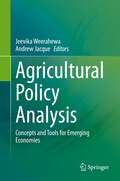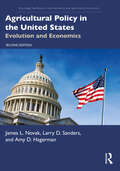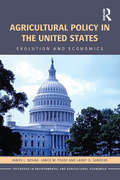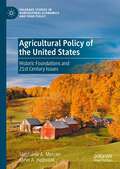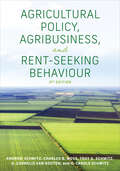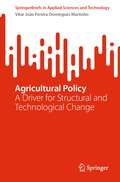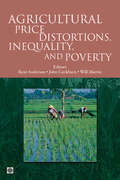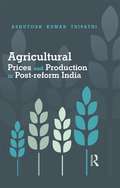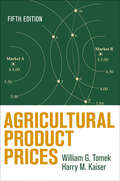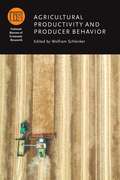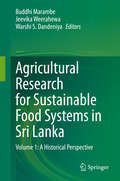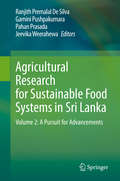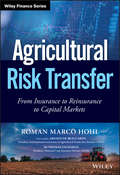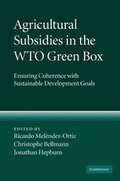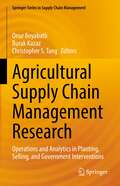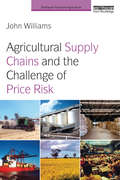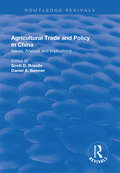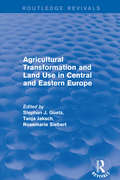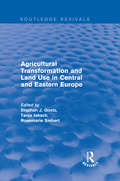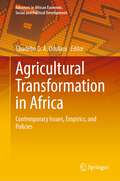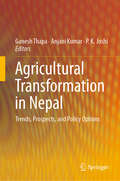- Table View
- List View
Agricultural Policy Analysis: Concepts and Tools for Emerging Economies
by Jeevika Weerahewa Andrew JacqueThis book is centred around various interwoven topics which are fundamental to policy analysis in agriculture. Key concepts and tools that are fundamental for the analysis of agricultural policies and programmes are presented. Key concepts introduced include, the role of the state in a market economy with examples from the Sri Lankan and other developing economies, the international trade environment, and conceptual frameworks for analysing important domestic and international trade policies. It also highlights interconnections among agriculture, development, policy and illustrates the extent to which the agricultural sector contributes in achieving economic growth objectives, equity and equality objectives and environmental objectives. The book takes the readers through the nature of agricultural markets in developing countries, with special emphasis on Sri Lanka, and illustrates how the degree of competitiveness is measured at various market levels using multiple indices and methods. Several tools, with accompanying case studies, for the analysis of policies and programmes are detailed. These tools include the GTAP model, gravity models, extended benefit cost analysis, and linear programming. Tools and models are applied to the analysis of trade policies and agreements, marketing policies, environmental services, extension programmes, land tenure reforms and climate change adaptations. Case studies in relation to the agri-food policy and strategy response to COVID-19 Pandemic are also covered. This book is of interest to public officials working in agricultural planning and agricultural policy, teachers, researchers, agro-economists, capacity builders and policymakers. Also the book serves as additional reading material for undergraduate and graduate students of agriculture, development studies, and environmental sciences. National and international agricultural scientists, policy makers will also find this to be a useful read.
Agricultural Policy in the United States: Evolution and Economics (Routledge Textbooks in Environmental and Agricultural Economics)
by James L. Novak Larry D. Sanders Amy D. HagermanAgricultural Policy in the United States: Evolution and Economics traces U.S. agricultural policy from its colonial roots to the present, using economic concepts to analyze and interpret political and economic consequences. It also examines the processes by which agricultural policies are developed, and the government structure which supports the implementation of legislation passed by Congress. The book includes arguments for and against common tools of U.S. agricultural policy, without influencing the reader in a particular direction. Each chapter contains questions and exercises to support students’ learning, and technical economic material is contained in optional appendices. This second edition examines the Agriculture Improvement Act of 2018 and sets the scene for future policy developments. Additionally, it looks at trade wars and the impact of Black Swan events like the COVID-19 pandemic on agricultural resilience.
Agricultural Policy in the United States: Evolution and Economics (Routledge Textbooks in Environmental and Agricultural Economics)
by James L. Novak James W. Pease Larry D. SandersAgricultural Policy in the US: Evolution and Economics traces the foundation of US agricultural policy from its colonial roots to the present, using economic concepts to analyze and interpret political and economic consequences. Ancient Roman food and agricultural reform, English Corn Law and other historic examples of agricultural policies are included to show that agricultural policy has a long history and has been found necessary for governance throughout history. Processes employed to develop US agricultural policies, the structure and function of government that develops and implements agricultural policy, and the specific evolution of policy from the early twentieth century to the Agricultural Act of 2014 are included. Specific policies in past farm bills are detailed in order to track their evolution and economic effects. This textbook includes arguments for and against common tools of US agricultural policy. This debate continues today and can be seen in a gradual change over time from taxes and tariffs to risk management. Information presented does not attempt to influence the readership towards a pro or con position but rather to present information to help the readers to understand the issues related to agricultural policy in the US.
Agricultural Policy of the United States: Historic Foundations and 21st Century Issues (Palgrave Studies in Agricultural Economics and Food Policy)
by Stephanie A. Mercier Steve A. HalbrookThis book serves as a foundational reference of U.S. land settlement and early agricultural policy, a comprehensive journey through the evolution of 20th century agricultural policy, and a detailed guide to the key agricultural policy issues of the early 21st century. This book integrates the legal, economic and political concepts and ideas that guided U.S. agricultural policy from colonial settlement to the 21st century, and it applies those concepts to the policy issues agriculture will face over the next generation. The book is organized into three sections. Section one introduces the main themes of the book, explores the pre-Columbian period and early European settlement, and traces the first 150 years of U.S. agricultural policy starting with the post revolution period and ending with the “golden age” of agriculture in the early 20th century. Section two outlines that grand bargain of the 1930s that initiated the modern era of government intervention into agricultural markets and traces this policy evolution to the early days of the 21st century. The third section provides an in-depth examination of six policy issues that dominate current policy discussions and will impact policy decisions for the next generation: trade, environment/conservation, commodity checkoff programs, crop insurance, biofuels, and domestic nutrition programs.
Agricultural Policy, Agribusiness and Rent-Seeking Behaviour, 2nd Edition
by Charles B. Moss Troy G. Schmitz Hartley Furtan Andrew SchmitzThe second edition of the groundbreaking Agricultural Policy, Agribusiness, and Rent-Seeking Behaviour expands upon its original analysis of the economic policies that affect agriculture and agribusiness. Widening their lens to include information on the European Union, the authors continue to emphasize the role of farmers and agribusiness in the formation of policy, exploring the issues from both economic and historical perspectives.More theoretical than the first volume in its discussions of welfare economics and the theory of public choice, the second edition also addresses the broad significance of agricultural policies such as biofuels, nutrition, multifunctionality, genetically modified organisms, and multinational firms. The authors maintain and expand the empirical content to provide more practical examples suited to teaching and analyse specific problems including price and income stabilization, science policy, environmental policy, and food quality and safety.
Agricultural Policy, Agribusiness, and Rent-Seeking Behaviour, Third Edition
by Troy G. Schmitz Andrew Schmitz Charles Moss G. Cornelis van Kooten H. Carole SchmitzCosting billions of dollars annually, international trade in agricultural products is impactful and influenced by several factors, including climate change, food policy, and government legislation. The third edition of Agricultural Policy, Agribusiness, and Rent-Seeking Behaviour provides comprehensive economic analyses of the policies that affect agriculture and agribusiness in Canada and the United States. Looking at current agricultural policies, the third edition includes new chapters on food pyramids, climate change, and GMOs, while also highlighting the effect of international policies on Canadian trade, including the problematic US ethanol policy. The new edition addresses current issues, including how the COVID-19 pandemic has negatively affected agricultural value chains and played a hand in the ongoing growth in opioid use. Including a number of key findings, and discussing current debates on topics including foreign ownership of Canadian farmland, Agricultural Policy, Agribusiness, and Rent-Seeking Behaviour will appeal to students in agricultural economics and policy, as well as policymakers, agricultural firms, energy companies, and readers wishing to reduce their nation’s carbon footprint.
Agricultural Policy: A Driver for Structural and Technological Change (SpringerBriefs in Applied Sciences and Technology)
by Vítor João MartinhoThis book gives insights into the agricultural policies in several countries located in different continents. It is of interest to students, researchers, and policy and decision makers.Given the particularities of agriculture, agricultural policies are indispensable for an adjusted development of farms according to the strategic objectives of each country, namely the socio-economic and environmental ones. The question that often arises is whether the practical effects of the various policy measures are in accordance with their design and what is the effect of these policy instruments among many other causes of structural and technological change. The aim of this book is to describe the main agricultural policies that have been implemented in countries such as the United States of America, Brazil, China, India, South Africa, Australia, as well as the European Union. It also aims to analyse the real impact of these policies on the structural and technological changes of farms in the European Union. As its methodology, the book considers bibliometric analysis, literature review and statistical approaches.
Agricultural Price Distortions, Inequality, and Poverty
by Kym Anderson Will Martin John CockburnThe prices of farm products are crucial determinants of the extent of poverty and inequality in the world. The vast majority of the world's poorest households depend to a considerable extent on farming for their incomes, while food represents a large component of the consumption of all poor households. For generations, food prices have been heavily distorted by government policies in high-income and developing countries. Many countries began to reform their agricultural price and trade policies in the 1980s, but government policy intervention is still considerable and still favors farmers in high-income countries at the expense of many farmers in developing countries. What would be the poverty and inequality consequences of the removal of the remaining distortions to agricultural incentives? This question is of great relevance to governments in evaluating ways to engage in multilateral and regional trade negotiations or to improve their own policies unilaterally. 'Agricultural Price Distortions, Inequality, and Poverty' analyzes the effects of agricultural and trade policies around the world on national and regional economic welfare, on income inequality among and within countries, and on the level and incidence of poverty in developing countries. The studies include economy-wide analyses of the inequality and poverty effects of own-country policies compared with rest-of-the-world policies for 10 individual developing countries in three continents. This book also includes three chapters that each use a separate global economic model to examine the effects of policies on aggregate poverty and the distribution of poverty across many identified developing countries. This study is motivated by two policy issues: first, the World Trade Organization's struggle to conclude the Doha Round of multilateral trade negotiations, in which agricultural policy reform is, again, one of the most contentious topics in the talks and, second, the struggle of the developing countries to achieve their Millennium Development Goals by 2015-notably the alleviation of hunger and poverty-which depends crucially on policies that affect agricultural incentives.
Agricultural Prices and Production in Post-reform India: An Inquiry Into The Post-reform Period
by Ashutosh Kumar TripathiPost-reform India has seen a decline in agricultural growth as well as supply–demand imbalance and rising prices. This book presents a comprehensive analysis of domestic and international prices and trade since 1980–81, covering the past quarter of a century. Backed with rich data, it provides comparisons between the pre- and post-liberalisation policies and their effect on farm profitability, domestic prices and prices variability, and examines their possible role in determining the trajectory of agricultural growth since 1991. The book will appeal to students, scholars and researchers of agriculture studies, economics, finance, and development studies, as well as policy makers and agriculture experts.
Agricultural Product Prices
by Harry M. Kaiser William G. TomekPublished continuously since 1972, Agricultural Product Prices has become the standard textbook and reference work for students in agricultural and applied economics, buyers and sellers of commodities, and policymakers, clearly explaining conceptual and empirical models applicable to agricultural product markets. The new fifth edition uses up-to-date information and models to explain the behavior of agricultural product prices. Topics include price differences over market levels (marketing margins), price differences over space (regionally and internationally) and by quality attributes, and price variability with the passage of time (seasonal and cyclical variations, trends, and random behavior). William G. Tomek and Harry M. Kaiser review and adapt microeconomic principles to the characteristics of agricultural commodity markets and then apply these principles to the various dimensions of price behavior. They also provide an in-depth discussion of prices established for futures contracts and their relationship to cash (spot) market prices; cover the influential roles of price discovery institutions, such as auctions and negotiated contracts, and government policies regulating trade and farms; and discuss the specification, use, and evaluation of empirical models of agricultural prices, placing emphasis on the challenges of doing high-quality, useful analyses and interpreting results.
Agricultural Productivity and Producer Behavior (National Bureau of Economic Research Conference Report)
by Wolfram SchlenkerAgricultural yields have increased steadily in the last half century, particularly since the Green Revolution. At the same time, inflation-adjusted agricultural commodity prices have been trending downward as increases in supply outpace the growth of demand. Recent severe weather events, biofuel mandates, and a switch toward a more meat-heavy diet in emerging economies have nevertheless boosted commodity prices. Whether this is a temporary jump or the beginning of a longer-term trend is an open question. Agricultural Productivity and Producer Behavior examines the factors contributing to the remarkably steady increase in global yields and assesses whether yield growth can continue. This research also considers whether agricultural productivity growth has been, and will be, associated with significant environmental externalities. Among the topics studied are genetically modified crops; changing climatic factors; farm production responses to government regulations including crop insurance, transport subsidies, and electricity subsidies for groundwater extraction; and the role of specific farm practices such as crop diversification, disease management, and water-saving methods. This research provides new evidence that technological as well as policy choices influence agricultural productivity.
Agricultural Research for Sustainable Food Systems in Sri Lanka: Volume 1: A Historical Perspective
by Buddhi Marambe Jeevika Weerahewa Warshi S. DandeniyaA food system comprises the entire range of actors and interlinked activities related to food production, processing, distribution, marketing and trade, preparation, consumption, and disposal. When a food system operates without compromising the needs of future generations, it is considered to be a “Sustainable Food System.” The present-day food systems in Sri Lanka are diverse, and the natural and physical environment, infrastructure, institutions, society and culture, and policies and regulations within which the food systems operate, as well as the technologies employed, have shaped their outcomes. Agricultural research is a key factor in terms of innovation and technological advances. Innovation has been the main driver of food systems’ transformation over the past few decades and will be critical to addressing the needs of a rapidly growing population in a context of climate change and scarcity of natural resources. In addition, agricultural research must help meet the rising demand for food at affordable prices. Comprising 17 chapters written by specialist(s) in their respective subject-areas, this Contributed Volume on “Agricultural Research for Sustainable Food Systems in Sri Lanka: A Historical Perspective” shares the scientific knowledge accumulated by the National Agricultural Research System of Sri Lanka, including universities, and offers recommendations on how to make food systems more sustainable in order to address the current needs of Sri Lankan society. It presents perspectives on four key thematic areas, namely: (i) Crop and animal production, management, and improvement, (ii) Agro-product processing technologies, (iii) Natural resource management, and (iv) Socio-economic development and agri-business management.
Agricultural Research for Sustainable Food Systems in Sri Lanka: Volume 2: A Pursuit for Advancements
by Jeevika Weerahewa Ranjith Premalal De Silva Gamini Pushpakumara Pahan PrasadaFood systems involve a range of activities concerning food production, processing, distribution, marketing and trade, preparation, consumption and disposal. They encompass the path of food from the farm to the dinner table, meeting the food and nutritional needs of a nation. When such systems do so without sacrificing the needs of future generations, they are referred to as “Sustainable Food Systems.” The natural and physical environment, infrastructure, institutions, society and culture, and policies and regulations within which they operate, as well as the technologies they adopt, shape these systems’ outcomes. Making food systems more sustainable is a key priority for all nations, and Sri Lanka is no exception. Food systems deliver optimal performance when the policy and regulatory environment is conducive, institutions are supportive, and a combination of agricultural research investments and an efficient extension system generates the technologies and scientific evidence required for sound policymaking and agenda setting. Further, agricultural research can generate essential findings, technologies and policies for sustainable agricultural development – across disciplines, sectors and stakeholder groups. This book shares valuable insights into research conducted in the broad food and agriculture sectors in Sri Lanka. It also discusses the status quo in related disciplines, and outlines future research directions. Accordingly, it offers a valuable source of reference material for researchers, students, and stakeholders in the food and agriculture sectors, while also highlighting the types of support that policymakers and other decision-makers can provide.
Agricultural Revolution without a Land Revolution: the Megafarms of CP Group
by William C. Kirby Nancy Hua DaiThis case describes the megafarm model launched by the CP group as part of their efforts to ensure the safety and quality of their supply chain of agricultural products (particularly, eggs) in China while also promoting the welfare of Chinese farmers. This model was developed in close partnership with the local government, and received financing support from a local bank. The case asks students to discuss the potential for scaling this model across China.
Agricultural Risk Transfer: From Insurance to Reinsurance to Capital Markets (Wiley Finance)
by Roman Marco HohlGain a holistic view of agricultural (re)insurance and capital market risk transfer Increasing agricultural production and food security remain key challenges for mankind. In order to meet global food demand, the Food and Agriculture Organisation estimates that production has to increase by 50% by 2050 and requires large investments. Agricultural insurance and financial instruments have been an integral part to advancing productivity and are becoming more important in increasingly globalized and specialized agricultural supply chains in the wake of potentially more frequent and severe natural disasters in today’s key producing markets. Underwriting, pricing and transferring agricultural risks is complex and requires a solid understanding of the production system, exposure, perils and the most suitable products, which vastly differ among developed and developing markets. In the last decade, new insurance schemes in emerging agricultural markets have greatly contributed to the large growth of the industry from a premium volume of US$10.1 billion (2006) to US$30.7 billion (2017). This growth is bound to continue as insurance penetration and exposure increase and new schemes are being developed. Agricultural (re)insurance has become a cornerstone of sovereign disaster risk financing frameworks. Agricultural Risk Transfer introduces the main concepts of agricultural (re)insurance and capital market risk transfer that are discussed through industry case studies. It also discusses best industry practices for all main insurance products for crop, livestock, aquaculture and forestry risks including risk assessment, underwriting, pricing, modelling and loss adjustment. Describes agricultural production risks and risk management approaches Covers risk transfer of production and financial risks through insurance and financial instruments Introduces modelling concepts for the main perils and key data sources that support risk transfer through indemnity- and index-based products Describes risk pricing and underwriting approaches for crop, livestock, aquaculture and forestry exposure in developed and developing agricultural systems Become familiar with risk transfer concepts to reinsurance and capital markets Get to know the current market landscape and main risk transfer products for individual producers, agribusinesses and governments through theory and comprehensive industry case studies Through Agricultural Risk Transfer, you’ll gain a holistic view of agricultural (re)insurance and capital market solutions which will support better underwriting, more structured product development and improved risk transfer.
Agricultural Sector in India: Accelerating Growth and Enhancing Competitiveness
by MruthyunjayaThis book presents a comprehensive overview of a range of concepts, methods, strategies and policies in agriculture and natural resource management, environmental economics, production economics and sustainable agricultural development. It explores effective analytical tools and science, innovations, and management solutions to enhance yields, manage the supply chain, strengthen institutional mechanisms, and service and support systems for farmers. It highlights the importance of enabling policies which can benefit farmers, resulting in cost-efficient and quality-improving farm practices, increased profits and income for farmers, and better management of natural resources. The essays in the book honour the academic, teaching, and research contributions of Professor R. Ramanna in the field of agricultural economics. They also address issues which are relevant to the growing research in sustainable agricultural development and natural resource management including the use of new concepts, tools, analyses, technologies, innovations, and policy strategies modelled in local contexts that can easily be scaled and applied to similar contexts elsewhere. This book will be of interest and use to students, researchers, practitioners,and policymakers working in varied fields of agricultural economics, sustainable development, public policy, rural sociology, political economy, economics of innovation, institutional economics, and industrial organisation.
Agricultural Subsidies in the WTO Green Box: Ensuring Coherence with Sustainable Development Goals
by Ricardo Meléndez-Ortiz Christophe Bellmann Jonathan HepburnDo the World Trade Organization's rules on 'green box' farm subsidies allow both rich and poor countries to achieve important goals such as food security, or do they worsen poverty, distort trade and harm the environment? Current WTO requirements set no ceiling on the amount of green box subsidies that governments can provide, on the basis that these payments cause only minimal trade distortion. Governments are thus increasingly shifting their subsidy spending into this category, as they come under pressure to reduce subsidies that are more directly linked to production. However, growing evidence nonetheless suggests that green box payments can affect production and trade, harm farmers in developing countries and cause environmental damage. By bringing together new research and critical thinking, this book examines the relationship between green box subsidies and the achievement of sustainable development goals, and explores options for future reform.
Agricultural Supply Chain Management Research: Operations and Analytics in Planting, Selling, and Government Interventions (Springer Series in Supply Chain Management #12)
by Christopher S. Tang Onur Boyabatlı Burak KazazThis book focuses on three essential elements of agricultural supply chains: Planting and Growing, Processing and Selling, and Government Interventions. For decades, most agricultural economists applied macro-economic theory in decisions pertaining to the optimization of food production and distribution. However, few researchers used micro-economic theory to examine how individual farmers respond to market information, incentive pricing mechanisms and different market structures in the trade of agricultural goods. Examining challenges in agricultural supply chain operations through the lens of micro-economic theory is imperative because it can enable policymakers and social enterprises to develop and design market information provision policy, incentive contracts and market structures for improving farmer and consumer welfare.In each chapter, contributing authors motivate their research questions by providing the context and articulating the importance of their questions. They present their analysis to examine the respective research questions and explain their results. At the end of each chapter, they provide a short list of future research questions.
Agricultural Supply Chains and Industry 4.0: Technological Advance for Sustainability
by Stella Despoudi Konstantina Spanaki Oscar Rodriguez-Espindola Efpraxia D. ZamaniThis book explores the impact of industry 4.0 on agricultural supply chains, exploring how changes such as increased digitisation, automation, and the digital value chain, will impact food production globally.At a time when increasing population and environmental degradation puts stress on food supply chains, traditional farming operation models struggle to maintain both sustainability and transparency. Industry 4.0 could lead to digitalised ways of farming and agricultural production processes that will transform the traditional operating and process models to digital, data-intensive methods focusing on analytics and decision-making practices.This book aims to provider the reader with an understanding of the concept of Agriculture 4.0 in relation to supply chain management. Different applications of Agricultural 4.0 supply chains are discussed in relation to their respective advantages and disadvantages.Dr. Stella Despoudi is Lecturer in Operations and Supply Chan Management at Aston University and Adjunct Lecturer in Supply Chain Management at the University of Western Macedonia, Greece.Dr. Konstantina Spanaki is a Lecturer in Information Management at Loughborough University, UK.Dr. Oscar Rodríguez-Espíndola is a Senior lecturer in Operations and Supply Chain Management at Aston University and a member of the Aston CRISIS centre, UK.Dr. Efpraxia Zamani is a Senior Lecturer of Information Systems at the University of Sheffield, UK.
Agricultural Supply Chains and the Challenge of Price Risk (Earthscan Food and Agriculture)
by John WilliamsThis book discusses the issues of integration within food and fibre supply chains and the challenges in managing price risk. The problems of integration and price risk are interwoven in agricultural supply chains with production and supply risk as well as hoarding. However, without supply chain integration through commercial trade markets there can be no forward market upon which forward transactions and the management of price risk can be based. Without a forward market that can reduce opportunistic behaviour, there is likely to be little security of supply, particularly under high production risk and price uncertainty. Whilst price risk management is possible under certain circumstances, there are many factors that can prevent the development of forward markets or cause them to collapse, thus undermining the ability to manage price risk within acceptable risk and return parameters. Market positions therefore need to be valued and often settled daily due to the risk of contract default. In addition, the issue of currency risk and its management applies to international market positions and transactional exposures. The book analyses a range of price risk management strategies from forward contracting through to futures and options hedging, and finally to over-the-counter products. Evaluation techniques are developed to aid decision-making. The author concludes that forward market development may be the exception rather than the norm, and that whilst favourable price risk management outcomes may be possible, they can sometimes be caused more by luck than through good management. It is shown how tactics are an important consideration in decision-making to minimize costs and losses.
Agricultural Trade and Policy in China: Issues, Analysis and Implications (The Chinese Trade and Industry Series)
by Ian Long Scott D. RozelleThis title was first published in 2003. This prominent and commanding volume collates the best research available on China's agricultural trade. Critically analyzing the agricultural supply and demand factors that underlie trade patterns such as agricultural productivity and policy, it also explores China's agricultural trade and policy including implications for China and elsewhere. Long term issues and productivity growth are taken into consideration, as are specific issues such as WTO accession. The slate of authors combines the leading established scholars in the field and the best of the next generation, including those from China and the West.
Agricultural Transformation and Land Use in Central and Eastern Europe
by Stephan J. Goetz Tanja JakschThis title was first published in 2001. By presenting research from a multi disciplinary perspective, this book will serve as an important reference tool for researchers and others interested in the land use issues of Central and Eastern Europe as well as agribusiness leaders seeking potential trading relations with and within these European countries.
Agricultural Transformation and Land Use in Central and Eastern Europe
by Stephan J. Goetz Tanja JakschThis title was first published in 2001. By presenting research from a multi disciplinary perspective, this book will serve as an important reference tool for researchers and others interested in the land use issues of Central and Eastern Europe as well as agribusiness leaders seeking potential trading relations with and within these European countries.
Agricultural Transformation in Africa: Contemporary Issues, Empirics, and Policies (Advances in African Economic, Social and Political Development)
by Gbadebo O. A. OdularuThis book offers new insights into the ongoing agricultural transformation in Africa. Presenting case studies, macro-level simulations, and relevant surveys, it analyzes food crops and agri-food policy challenges and their implications in various African countries. In addition, it discusses how current African agri-food policies could be improved to achieve the continental vision of sustainable development in light of the African Union’s Agenda 2063. The respective contributions address topics such as drivers of technical efficiency among smallholder maize farmers; farm management practices; agri-food infrastructure policies; food security; agricultural growth; and financing for and investment in agricultural production. Accordingly, the book appeals to scholars of economics and agricultural studies and to anyone interested in the agricultural transformation of Africa.
Agricultural Transformation in Nepal: Trends, Prospects, and Policy Options
by P. K. Joshi Ganesh Thapa Anjani KumarThis book addresses some key strategic questions related to agriculture in the context of major contemporary developments and emerging challenges in Nepal such as the changing role of agriculture with economic growth, structural transformation in reducing poverty, improving nutritional outcomes, and addressing the challenges of climate change. The book also suggests policy measures to improve the delivery of critical inputs and services and ensure the participation of marginal and smallholders in high-value chains. Further, it discusses how the new federal system and governance structure will affect the delivery of agricultural technology and services. The book is divided into five parts. Part I discusses macro-issues in the agriculture sector, while Part II focuses on agricultural productivity growth and its main drivers. The third part explores diversification in the agricultural and non-agricultural sectors by farmers and other rural people for livelihood improvement, while the fourth part deals with agricultural trade and marketing issues, highlighting policy implications and recommendations in the areas of immediate focus and further research. Lastly, Part V addresses institutions and governance issues, which are vital for agricultural development. In the final chapter, the editors summarize and synthesize the book’s main findings and develop a policy agenda for addressing the many challenges faced by the agriculture sector in Nepal, so as to make it more productive, competitive, sustainable, and inclusive. The book offers a rich source of analytical information on various aspects of agricultural development in Nepal and will be of immense value to policymakers, development partners, civil society, students, and those interested in the economic and agricultural development of not only Nepal, but also other developing countries.
